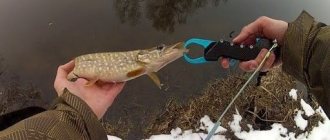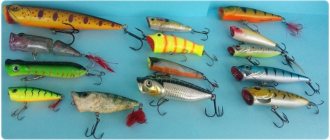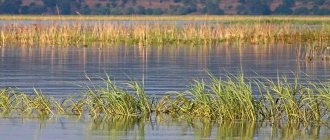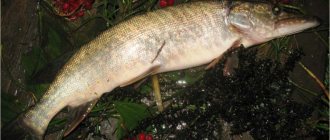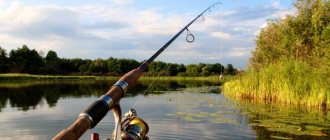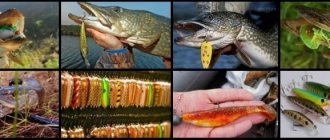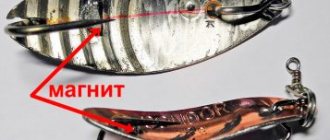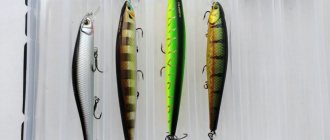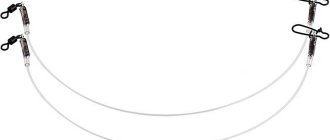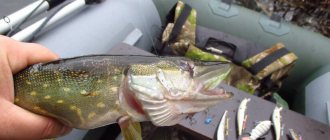What kind of bait is this?
A streamer is a bait that masterfully imitates fry, mice, tadpoles and frogs. It is most often made from synthetic materials, goose or chicken feathers, and rabbit fur. The choice of components is not accidental. They are the ones who are able to maintain the required volume in the water and guarantee the most natural game possible, lulling the vigilance of the fish.
The choice of material for streamers depends on what goals you are pursuing.
- synthetic ones have shown the greatest effectiveness when catching pike perch and pike perch. They perfectly retain their original shape and dry quickly, but do not “work” well in conditions of strong current;
- feathers are especially attractive to asps. They are distinguished by smooth, uniform movement. If you supplement them with a head made of deer fur, then such a bait will become the best in intense currents;
- fur . Ideal for both standing water and strong currents. Characterized by natural behavior. This bait is good for catching pike.
Regardless of the material of the streamer, your artificial bait will strikingly resemble live bait, which means that the likelihood of catching a trophy fish increases significantly.
Catching perch with a streamer
Perch can be caught with a streamer in a river or lake, even in a pond, gravel or clay pit. We recommend fishing in the lake - it is easier for several reasons: in particular, it is easier to avoid snags; can be fished while entering the water or from a boat, which makes it easier to use the line. This is especially important for novice anglers.
A lake with a large population of perches, with sloping slopes, with sandy or rocky shores - these factors play into the hands of the angler, making it easier for him to find perches and patiently select numerous baits, such as various streamers, until one of them appeals to the capricious fish.
Thickets on the shore, reeds in the water and on the bottom, and underwater meadows make fishing difficult, contributing to the loss of many streamers.
If extreme weather conditions are not expected, such as strong winds, or deep water of 5 meters or more, we recommend using a fly rod No. 6 AFTM, preferably with a fast action, complete with a moaning line or a line with a groaning end (Class II or III). Any type of leash no longer than 1.5 m is used; its thickness (0.15-0.18 mm) is chosen depending on the size of the fish.
Read: Autumn perch fishing with microjig
We recommend using a streamer designed for trout fishing. The colors and brightness of the streamer differ in different bodies of water, which is caused by the different preferences of local perches. A combination of black and red will work on one body of water, on another – brown and yellow, on a third – white and blue. On an unfamiliar body of water, you need to take 4-7 different streamers with you, given the capricious nature of perches. You need to patiently select the most effective bait.
Perch are mobile, moving in groups over a greater distance than the casting radius of the line, so the angler must be prepared to follow the perch. This applies to the situation during feeding of perches; during rest they stay in one place and at the same depth. First of all, you need to fish the layer near the surface, immersing the bait to a depth of 1 m. Next, you need to fish half-water at a depth and only at the end lower the streamer to the bottom, up to 3-4 m. The streamer needs to be led, pulling in short movements, changing direction for variety. and speed of movement. The perch bite can be very careful or sharp, combined with a jerk. To feel a careful bite, you should always position the rod parallel to the line, and perform the hooking with the palm holding the line. When casting against the wind, it is better to wear a sinking line because it will fly further.
Pros and cons of streamers
If we talk about the advantages, then it is worth noting, first of all, the high naturalness when guiding in shallow water, ease of mating and low weight. In addition, predators peck at streamers during periods of low activity.
It has been repeatedly proven that such bait awakens hunting instincts even when the “owner of the waters” is not hungry and chasing food is not part of his plans. And if you are lucky and you successfully throw the tackle into a school of fish, you can easily catch several individuals at a time.
It is impossible not to note the good passability of the bait in the grass and snags. It is equally effective at different depths. The compact size allows you to cast over long distances. At the same time, the streamer does not sail or spin. What makes the bait popular is its versatility and out-of-season nature. You can catch any fish with it at any time of the year.
But what about the cons? Do streamers have any disadvantages? Of course, it couldn’t have happened without them. The main disadvantage of this type of bait is the need for empty casting. Fur “fry” quickly absorb water, after which they are no longer so easy to cast. By the way, synthetic streamers do not have this drawback.
Fishing with streamers
There are two types of fishing with this bait:
Fly fishing
For this species, you need to choose gear that will be superior in power to the equipment for catching with a dry fly. It is recommended to choose tackle with a length of three meters and class 7/8. If you want to learn how to fish, then other flies that have less weight will suit you.
The cord must be chosen so that it matches the class of the fishing rod. You can choose either floating or sinking. This criterion must be determined based on the depth and type of fishing spot. For fishing on lakes, it is better to take a sinking line.
The size of the undergrowth should vary up to about a meter. This must be done in order to make it convenient to cast and control the fly. After casting, you need to let the bait fall to the desired depth, and make small pull-ups to bring the streamer into the water column. There is no need to control the bite, if your target is trout, the blow will be powerful enough and the fish will be detected on its own.
If, for example, your target is a perch, then you need to strike at the right time, it should be soft enough, since the perch has rather weak lips. Pay attention to the sharpness of the hooks, especially when fishing on lakes where the water is still. If the streamer is moved in an area where there is no current, then it may happen that you lose control of the fly.
At this point, a bite may occur, and a reliable and sharp hook will help you keep the fish until you feel the tugs. If you choose a river, then the requirements for selecting gear drop significantly. You can choose a standard floating line, which has a standard undergrowth.
The leash must be made by moving against the current, throwing the tackle in front of you and pulling the streamer down, while you need to select the cord. This way the fish feels more confident without the fisherman being aware of it.
Spinning fishing
In this case, there are both pros and cons. The advantages include the fact that every angler has such a rod, and assembling the equipment will not be difficult. But spinning players are used to making long casts, in this case this will not work.
There is, of course, an option. It is necessary to attach additional weights to the tackle, but in this case the desired effect will no longer be achieved, since the tackle will lose its lightness and will no longer perform so well under water. It is best to add just a little weight to the bait by adding lead wire to the hook or clamping several small weights on it.
Nuances of fishing
You can fish with streamers using a fly rod and spinning rod. When fly fishing, you should be especially careful when choosing a fishing rod. The optimal length is 2.4 m. It is also important to choose the right location. In autumn and winter, luck lies in wait in narrow canals, small lakes and ditches, near banks densely covered with vegetation. In summer it is better to fish near reed thickets, near large stones, and on rifts.
The ability to “read” water comes with experience. But most often, river bends, shallows and sharp changes in depth, and places overgrown with algae turn out to be promising. You should also take into account what the fish are currently feeding on and choose the most suitable one from the available streamers.
And also, in the warm season, give preference to dark streamers - black, burgundy, dark green. On cool days, predators prefer bright baits - light green, orange, golden.
The size of the bait largely depends on the size of the hunted object. For pike you need large streamers, for perch - smaller ones. Although there are exceptions. Sometimes the pike is caught on small things, and the miniature crucian carp tries to attack the large bait.
Subtleties of fishing and gear
What gear do you need for a streamer? Many people believe that this must definitely be a rod of at least class 9, equipped with a similar reel and appropriate cord. This choice is usually motivated by the fact that the streamer is a voluminous bait and there is no way to cast it with light class tackle. All this is true if you do not make some adjustments to the cord, casting technique, the dimensions of the bait itself and the materials from which it is tied.
Today, there are many models of cords designed for the use of bulk baits. Some of them, even with the most imperfect casting technique, are capable of lifting a small wobbler or popper from the water and sending it over a distance, not to mention a fur streamer. Therefore, by equipping even a class 5 fishing rod with such a cord, you can fish with a streamer. The rod class does not have to be high.
As for materials for streamers, today there are many flies knitted from ostrich feather, bucktail or synthetics, capable of creating a significant volume in the water with small dimensions. In addition, many synthetic fibers, such as holographic flash, lazer flash, mirror flash, mirage, are generally designed to increase the attractiveness of the bait even in the most muddy water.
The reflex properties of such materials are undeniable. You can tie a short fly, add a couple of such fibers, and the streamer will immediately be perceived by underwater inhabitants in a new way. In my opinion, Mark Pettyjean has been particularly successful in this field. His knitting technique is that the warp, spine or skin are removed from any material (be it feather or fur), which gives unwanted volume and precludes the use of a light-class rod.
A bait knitted from just beards or fur does not carry excess water and has less sail, and therefore can be made larger and used with light class gear.
Synthetic materials have played a big role in the design of the modern streamer; their advantages are obvious. It has become possible to create realistic lures, the color range has expanded, knitting some streamers has become much easier, and most importantly, they have become more durable.
Don’t forget about the streamer casting technique. Last season, I had the opportunity to meet many fly fishermen from different cities of Russia more than once. Among them were both beginners and experienced anglers, but what struck me most was that even very experienced fly fishermen often cannot perform such an element of casting as a “double pull”, and without it, fishing with a streamer is not very convenient.
When choosing gear for fishing with a streamer, the structure of the rod is important. In my opinion, a rod should be fast. Even the smallest streamer has a small volume, but this is a big minus when casting in windy weather. A fast action rod will help here. For a very long time I thought that the structure for streamer fishing rods was a secondary matter, until I found myself in real conditions, when a gusty wind blew from the right at the back and did not allow me to form a back loop.
With a medium-fast action rod, I just had to wait out the gusts of wind, otherwise the chance of hanging an “earring” knitted in the classical style on my ear increased many times over. All this continued until a friend standing next to me went to drink coffee, and I decided to try to catch him with a tackle. The result delighted me when, after another cast, a backing appeared in the entrance ring. Of course, I don’t encourage everyone to use only fast rods, but it doesn’t hurt to have one in your arsenal.
Perhaps the most important question in fly fishing is what to do after the bait lands on the water.
How to make a streamer with your own hands
As already mentioned, streamers can be made independently. There are no particular difficulties in this. You will need bird feathers (pigeons, ducks or chickens), animal wool (goats or sheep), fur (rabbit or squirrel), Lurex, woolen threads, foam rubber or New Year's "rain".
- take a scrap of wool, a bunch of feathers or a piece of fur and attach it to the hook so that the middle falls on the eye;
- fix the future bait with a nylon thread, wrap the free part of the feathers or wool towards the forearm;
- tie a double-folded base of a piece of fur or a bunch of feathers, forming a small thickening - the “head” of the fry;
- tie the thread in a knot, cut off the ends, comb the bait and apply waterproof glue to the thickening and knot;
- color the bait red, yellow or green.
But for the streamer to be truly useful, when making it, you should take into account the type of fish you are going to catch and wisely choose the hooks and color of the future bait.
- asp . To catch asp, streamers tied on hooks No. 6-10 are used. It’s good if the bait is painted white or red;
- perch _ In this case, you should take hooks No. 6-12. Recommended shades: light green, black, red, orange. The body of the fry can be made from marabou feathers, the head from a red bead, the tail from red rooster feathers;
- zander _ Streamers tied on hooks No. 4-10 made of artificial golden threads have the greatest catchability;
- trout . Hook numbers are 10-12. Favorite colors of trout are orange, light green, black. A streamer can be made from a simple synthetic dust brush or from thin satin ribbons;
- saberfish _ It is better to take hooks No. 6-10. Streamer color is shiny gray or white;
- pike . Experienced fishermen believe that catching pike with a streamer is a random occurrence. Whether you agree with this or not is up to you. One way or another, this cautious predator most often falls for perch flies.
As you can see, making a bait with your own hands is not difficult. Master the technique of fishing with a streamer if you have the desire - too. Apply the theoretical knowledge gained from this article in practice, and may luck accompany you always when you pick up a fishing rod!
How to make a streamer with your own hands
Making a vabik yourself is not difficult , and if you have some experience, production does not take much time.
Therefore, many fishermen prefer hand-tied streamers to purchased models. Reference. One of the advantages of a streamer is the wide scope for creativity that this type of lure provides.
When making wabiks with your own hands, you can endlessly experiment with materials, colors, shapes and sizes. For many fishermen, tying streamers becomes an activity that helps pass the evenings in winter , during periods of spawning bans and lack of biting. Making flies with your own hands is an interesting and exciting process that captivates many.
First, you should try
the simplest option :
- you need to take a bunch of wool 3-4 times longer than the hook ;
- attach it to the hook so that the middle is located in the eye area ;
- fold the bundle of hairs so that the part that extends beyond the eye is directed towards the hook ;
- fasten the wool to the hook by tying it with threads near the eye and at the same time making a thickening that will resemble the head of a fry ;
- All that remains is to saturate the threads with waterproof glue - and the streamer is ready .
This wabik can be made simply, and it shows good results in catching fish. You can use thread instead of wool. You need to wrap it around two, three, or four fingers of your hand in several turns, cut the resulting skein to make a bunch of threads of the required length, and then fasten it on a hook.
Important. When creating a streamer, you need to keep in mind that a voluminous and dense body reduces the likelihood of an effective hook. Such a bait often simply slips out of the fish’s mouth when the rod jerks. The lighter and more slender the plumage of the wabik, the greater the chances of realizing each bite.
After the first experiments, you can complicate the design of the manufactured streamers by introducing additional elements. At first, it makes sense to limit yourself to copying ready-made baits that show good catchability. This will allow you to understand the structure of wabiks , while simultaneously expanding the collection. Then you can start experimenting , trying to create your own original baits that will attract predators better than purchased models.
What it is?
A streamer is a fly fishing bait that, with its appearance and behavior when retrieving, imitates a small fish, insect, tadpole, frog and other object attractive to a predator. Essentially, this is a large fly designed for large prey. That is why it is so effective when fishing for pike and is popular for a reason.
Pike streamers can come in a wide variety of shapes and be made from different materials. Most often these baits are made from:
- animal furs;
- bird feathers;
- synthetic fibers.
Photo 1. Material for streamers.
Experienced fishermen use various combinations of these materials, creating real masterpieces that turn out to be very impressive, realistic and, of course, effective.
Each material for a pike streamer has its own characteristics, which must be taken into account when choosing a specific bait model. Synthetic materials dry quickly and can retain their original appearance for a long time. However, they do not behave well in strong currents.
Features of catching asp with a beard (streamer)
Catching asp on a spinning rod using a streamer is distinguished by its catchability, since the nozzle imitates mice, fry and toads well. Artificial materials, feathers and fur are often used to make a beard. The listed components hold well in water and allow high-quality imitation of prey.
Each type has its own characteristics:
- artificial. Particularly effective when hunting perch and pike perch. They keep their shape better than others, dry quickly, but lose their play when fishing in an intense current;
- feather Experienced fishermen always use feather options for asp, as they have an even and smooth game even during fast retrieves or fishing in the current. To improve the equipment, add a head made of deer fur; such equipment holds even better in fast currents;
- fur. They are universal models, suitable for any water surface. They do not lose their play during strong currents and remain attractive in still waters. Most often used for catching pike.
The best bait for fly fishing is an asp beard.
There are other features of the asp beard tackle:
- Asp are caught using a streamer during periods of low activity, especially in the heat. With the correct presentation, the fish’s hunting instincts awaken, then it attacks the bait;
- if you successfully throw the bait directly into a school of sheresper, there is a high probability of catching 2 individuals in one landing;
- the choice of this bait is justified in areas with an abundance of underwater vegetation and snags. When fishing with a spinning rod or fly fishing, the barb has less chance of getting tangled under water due to the compactness of the bait;
- It is good to fish with a streamer at all depths. After an accurate cast, you can catch the asp in deep holes or perform surface retrieves;
- The manufacturing technology uses lightweight materials that do not allow long casts. A sinker is used to deliver bait over long distances;
- the bait is suitable for fishing on any current using different fishing styles, since it does not sail and is resistant to entering a corkscrew;
- The beard rig for asp fishing can be used in all seasons and shows good results all year round;
- It is important to make accurate casts right away; fur models quickly get wet and lose their catchability. Synthetic and feather options are better able to withstand getting wet;
- It is better to attach attractive devices to the tail of the streamer, but not bright ones. Beards that imitate the appearance of the inhabitants of a particular body of water perform better. The colors may be different, but the following products show themselves well on asps: gray, white and black products. Some bright colors help catch asp, but solid varieties are still better;
- The asp attacks prey that is 4-5 times smaller than itself. Taking this feature into account, the nozzle is prepared from 5 to 8 cm in length.
Advantages of bait
Catching pike with streamers can be successful at any time of the year. Regardless of the fishing season, the toothy beast readily responds to a passing object, which has realistic shapes and imitates real prey with its movements.
Pike streamers are a phenomenal bait that has a number of advantages:
- Although it is intended for fly fishing, it can also be successfully used in spinning. It can be cast using lightweight ultralight rods and thin lines. This bait is suitable for different types of fishing.
- Streamer is a unique bait that allows for the most diverse animation techniques. It works great with a uniform feed and responds to any jerks and pulls.
- The bait is suitable for fishing in shallow water. Thanks to its light weight and windage, the streamer can be carried at a slow speed along overgrown shallows and spits.
- The streamer is used both on active toothy predators and on sluggish passive pike. It is good at seducing apathetic fish that refuse to take other baits.
- The bait has good permeability, so it can be used among algae and snags.
Tying a simple but working streamer for pike is quite simple. Therefore, any angler should not ignore this simple, but very effective bait. It must be in the arsenal of any fly fisherman or spinning angler involved in ultralight fishing.
Photo 3. Fantasy streamer.
No matter how much they praise the streamer for catching toothy pike, any, even the most versatile and productive bait, has its drawbacks:
- Many streamers are not able to withstand the greedy bites of a predator for long, so the baits cannot be called durable.
- Streamers made of fur or feathers quickly become wet and may lose some of their positive properties. This often affects the range of baits.
- Properly selected and sensitive gear is required to guide streamers. With an unbalanced set, you shouldn’t count on stable catches.
In general, a streamer for pike is more of a positive and simple bait that any hunter of a toothy beast needs to have in his box. You should definitely try fishing for it. Perhaps she will become “number one” for many years.
Once again about fly fishing with a streamer
or general approaches to fishing with large flies.
Author:
Oswys
A little boring:
Varied casts are not a show-off at all and were invented for fishing in the current and are designed to help the fly fisherman change the direction of casting with a minimum amount of manipulation, often in limited space. It is also necessary to remember that the choice of casting depends on the direction of the wind and, first of all, for safety reasons. It is necessary to understand that you will be able to fly fish consistently only when you learn to make accurate and, most importantly, safe casts from any bank of the river, in any direction of the wind, learn to recast a fly that has been blown away by the current, learn to understand your gear and manage it competently, retrieving is not easy in a promising place, but in the desired horizon. For example, sometimes the ability to perform mending (changing the position of the line on the water in order to influence the speed of the retrieve or, more simply put, repositioning the line that has been carried away by the current) is decisive for the success of fishing. Often observing the casting and retrieving done by some fly fishermen, I asked the question: “in what horizon, in your opinion, is the fly moving in the most promising place?” I received the answer: “near the bottom.” In fact, the fly was buried no more than 0.5 meters at a depth of 2-2.5 meters. What, then, could be the result? Random at best.
Object of fishing: predator and other large fish that have grown to the size when they begin to feed on fry. Tackle.
The main attention should be paid to the cord. It is the cord that pulls the streamer and its (the cord’s) carrying capacity determines the comfort of fishing. As a rule, short-headed cords are more suitable for beginners. Choosing a cord for casting heavy and/or voluminous streamers, in general, is not at all complicated and depends on the fishing conditions in which you most often fish and the casting techniques you have.
Option 1: open waters, no interference from behind (or when fishing from a boat).
Cord.
In this case, it is possible to use overhead casting and it is more logical to use lines in which the bulk of the line head is shifted to the front part. In other words, the cord has a short front taper and a longer back taper. One of the well-known and inexpensive ones is the KOLA SALMON SHOOTING TAPER cord.
A similar cord can be made from a regular cord several grades higher by cutting the front cone.
Rod.
The one-handed one from grade 7 is most preferable.
Option 2: cramped conditions, in a wade, with trees, bushes, reeds or just rocks behind you.
In such conditions, the use of overhead casting is impossible or can be extremely difficult.
Cord.
In this case, it is more logical to use spey casts and, accordingly, lines with a long front cone and a shift of mass towards the rear.
Of the well-known and controversial Royal Wulff Ambush
Rod.
A switch or two-hander from grade 5 is preferable.
Coil.
Unlike catching small fish, where there is only one requirement for the reel - to store the line, when catching large fish the reel must satisfy the following conditions:
1) The capacity and diameter of the spool must accommodate, in addition to the cord, a sufficient amount of backing and ensure quick winding of the running line, which in turn will allow you to work with a reel, rather than fishing the fish with your hands by the cord.
2) Good friction brake and protection from sand and moisture. The coil may not work at the right time due to sand getting inside.
Equipment set.
In order for the fishing process to be as comfortable as possible and not force you to “fight”, in addition to the wind, current and underwater obstacles, you must also observe/take into account the following points with your gear:
1) the equipment of the tackle must be such as to ensure its position in the water at an angle to the surface. If this condition is met, the tackle/streamer will be much better at overcoming various obstacles (edges, etc.)
2) It is possible, and sometimes it may be necessary, to use a cheater (extension insert between the cord and the polyleader) with a length of 1.5 to 3 m with varying degrees of immersion.
3) It is necessary to observe the drop in diameter/weight from the cord to the cheater (if used) and from the cheater to the polyleader/replacement end.
4) The depth that can be “reached” by the tackle is approximately
half of the sinking part, adjusted for current.
5) Depending on the line (skagit head) used with your switch rod, it may be better to use 10 or 15 foot salmon polyleaders or 120 grain interchangeable ends.
6) It is not necessary, but it is desirable that the weakest link in the tackle be the leash. This condition will help you keep the cord and/or polyleader (quite expensive elements of gear) from sliding off the cover when hooked.
7) Another point worth remembering: the thickness of the rig can affect the depth much more than its sinking properties. For example, retrieving a heavy fly on a thin floating line in a current can be much deeper than a sinking polyleader.
Examples of equipment configurations for beginners to understand:
1)
Shallow water, possibly overgrown, with windows.
Floating cord (or skagit head on a running line) + a piece of fishing line 0.4-0.5mm. + braided multi-strand leash + various surface streamers, preferably with protection against snags.
Several options from the many possible snag-resistant streamers
Frog Something like a mouse Popper
2)
Other places with depth and possibly with current.
Floating cord (or skagit head on a running line) + quick-sinking polyleader (or replaceable end) + braided stranded leash + streamer loaded with brass or tungsten dumbbell eyes, lead on the fore-end, etc. (options are possible). Loading depends on depth and current.
Several options for different streamers with the possibility of loading when tying a fly or with an olive weight of 30-40 cm.
Goby Zonker Malek
Selecting a streamer.
When choosing/knitting streamers, you need to consider the following:
1) When crocheting streamers, you need to be “moderate” in the amount of materials attached to the hook. It is better if your streamer is both voluminous and at the same time translucent. The advantage is that the streamer will absorb/retain less water and therefore be easier to cast.
2) Streamers that change volume in water, “breathing in water,” should not be enclosed - this will significantly worsen their performance.
Perhaps, when knitting, you should not immerse any streamers at all, and change the degree of immersion with a lead olive from 0.5 grams per 30 cm. from the streamer (see figure). The advantages are obvious: there is no need to knit a lot of streamers of varying degrees of “thinness” and a quick change of load in case of changes in depth and current.
3) Excellent results are achieved by fishing with a streamer with positive buoyancy. For deepening, a sinking polyleader or load 30-40 cm from the streamer is used. In this case, the streamer must be tied with a Rapal loop.
Option 1:
an example of a fly with positive buoyancy Booby nymph and the position of the fly in the water.
The buoyancy of the fly is ensured by eyes made of foam or foam balls. Option 2:
an example of another design of a fly with positive buoyancy and the position of the fly in the water
4) The streamer wing must be made optimal in order to eliminate overlaps over the bend of the hook. It is possible to use various tricks when knitting, for example, a loop of fishing line under the tail of the streamer.
5) Streamers should not be knitted on hooks with a very long shank in relation to the size of the streamer. This type of forend has very good leverage and can be easily turned out of the fish’s mouth.
Catching.
Before casting, the streamer must be moistened generously with water. This is necessary so that, after casting, the streamer takes a natural position in the water.
Casting upstream. Next, the ability to perform mending is very important, otherwise the tackle, under the influence of the current, will tighten ahead of time and pull the streamer with it, which will no longer have time to reach the desired wiring horizon. When retrieving, the streamer can move in different horizons, depending on the intended trophy and fishing conditions. In general, when catching a predator, the streamer must move close to the bottom, sometimes touching it, or the bottom is touched by an olive weight located 30 cm from the streamer. Typically, when the streamer reaches the bottom, the line begins to tighten faster and you should start retrieving immediately.
Subtleties of pike fishing
Success in streamer fishing depends on several factors. Firstly, the fisherman needs to correctly determine the fishing location, since different parts of the reservoirs will be effective in different seasons. In summer, a large number of bites are expected near aquatic vegetation. These can be islands of egg capsules and pondweed, or a coastal strip of reeds and reeds. In winter, early spring and autumn, this bait is best used near grooves, edges, on riffles, and near various shelters near the shore.
Secondly, it is important to choose the most suitable streamer wiring. The more experienced the fisherman, the more animation techniques he knows. The variability of fishing techniques allows you to catch pike under any conditions. This skill is especially reflected when fishing a passive toothy beast standing motionless in a shelter.
You can fish with these baits in various bodies of water, but the most interesting and exciting is fly fishing for pike on small rivers. Here, almost all of the predator’s exits and subsequent bites are visible to the fisherman, which brings a lot of emotions. Often the fish attacks the streamer right under your feet, making a powerful and sharp jerk. Such incidents are remembered for a long time and are pleasant to remember on boring evenings during the off-season.
Choice of materials color
One of the important issues that a fly fisherman faces when choosing a streamer is its color. It is difficult to give any recommendations in this matter.
Over the years of my passion for fly fishing and streamer fishing, as well as salmon fishing, I have developed my own preferences. But on a new river, I try to adhere to traditional advice on choosing the color of the bait.
What kind of fish you are going to catch is also important. Here is an example from personal practice on a paid reservoir. The red Furabou caught trout well, but as soon as I put the white one on, pike began to be caught. Taking into account such nuances, we can only give general recommendations on choosing the color of the bait.
